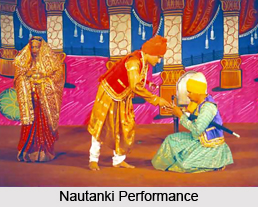 Akharas of Nautanki, or the "Schools of Nautanki", as they are also known, can be differentiated into five important parts like - Hathras, Muzaffarnagar, Saharanpur, Kanpur and Kannauj, each named after the town in which it originated. Out of the five given options, Hathras and Kanpur stand out for their individual styles. The Hathras was given a robust form by Indarman and perfected by his pupil Natharam Gaur of Hathras. The Kanpur is led by Srikrishan Pehalwan, an actor-singer-composer-wrestler of Kanpur who owned a Nautanki company. Both these men were exceedingly popular around fifty years ago.
Akharas of Nautanki, or the "Schools of Nautanki", as they are also known, can be differentiated into five important parts like - Hathras, Muzaffarnagar, Saharanpur, Kanpur and Kannauj, each named after the town in which it originated. Out of the five given options, Hathras and Kanpur stand out for their individual styles. The Hathras was given a robust form by Indarman and perfected by his pupil Natharam Gaur of Hathras. The Kanpur is led by Srikrishan Pehalwan, an actor-singer-composer-wrestler of Kanpur who owned a Nautanki company. Both these men were exceedingly popular around fifty years ago.
Contribution of Natharam and Hathras School
Natharam started his career as a young boy. He had a melodious voice and danced superbly. He played the heroine, always a beautiful princess or the daughter of a chief. Indarman`s troupe became famous because of Natharam. When Indarman grew old, he handed over the company to Natharam, who established a big professional troupe in Hathras. For years Natharam held sway over Uttar Pradesh, earning fame and fortune. His Nautanki, with its densely textured singing, erotic acting, and lusty dancing became the famous Hathras School. Over sixty plays, including Raja Harishchandra and Siyah Posh, are ascribed to him, though at least half of these were actually written by Indarman and other people.
The Hathras School has produced many famous actors. Karan, a good singer and dance director, appeared on the stage with over two hundred medals, pinned to his satin tunic. Actresses were an additional attraction in his troupe. Deep Chand, popularly known as Deepa was a favourite thirty years ago. His troupes travelled up to Kolkata and Rangoon. Now over eighty, he lives in retirement in a village in the Braj area. Anno and Shyama, two Nautanki dancing girls of Etawah were tremendously popular in the thirties. They still take part in Nautankis and still have dancing power because of their personalities. They have ringing voices and perform well even in the present days.
Difference between Kanpur and Hathras School
The Kanpur school, though it uses the same text, differs in its style of singing and production. The Hathras lays stress on classical singing and ignores dramatic action. The Kanpur style is simpler, subordinating singing to the needs of dramatic action. In the Hathras, the invocation is sung by Ranga, after which he introduces the play. Before the invocation, the singer sings a dhrupad (a majestic, slow, classical form) always in the honour of God - Lord Shiva, Lord Rama and Lord Krishna. Dhrupad singing demands a highly trained voice, well grounded in classical art. Not many dhrupad singers are left in Nautanki. The tradition is dying. In the Kanpur style, the actors do not sing an invocation but bow to the instruments, offer a Muslim salaam and squat on the stage, then follows a Nagma (a style of song).
Kanpur troupes perform on a picture-frame stage. The drop curtain shows the palace or a garden with the name of the company inscribed on it. Three more curtains represent the jungle, the bazaar and the court. The players enter and exit from the wings. The audience sits in the front. The Kanpur style has changed the folk character of staging and absorbed all the vices of decadent professional theatres. The Hathras, on the other hand, is open and free, played on a three foot high rectangular stage surrounded by spectators. The orchestra sits in a semicircle on the stage. The actors move freely on all sides. Boys playing female roles are a big attraction. Before the performance, they are kept hidden from the public gaze. The eager toddy-drunk spectators vie with one another in presenting gifts to them, and sometimes feuds erupt. One famous Nautanki "heroine" some thirty years ago was a good looking boy called Allah-hoo, who earned this name by singing the Allah-hoo song.
Participation of Women in Nautanki
Due to the presence of commercial character, Nautanki has attracted women performers. Its secularism has wiped out almost all of the religious elements, and it has become increasingly lewd. In the Indian state of Maharashtra, the Tamasha woman sparkles in a performance. In the north, the Nautanki woman is emerging.
In Kanpur, a Nautanki Company consisting solely of female artists makes use of film tunes and other cheap melodies and emphasises tantalizing gestures in its performances. The city corporation has banned the performance of Nautanki companies within municipal limits. The troupes perform on the outskirts of the city, and the townsmen flock to gay performances. But it is the old Nautanki troupes with their all-male cast that preserve the vigour, singing style and the operatic beauty of the form.
Some folk theatrical forms closely resembling Nautanki are the Bhagat of Agra, the Khyal of Rajasthan and Maanch of Madhya Pradesh.



















